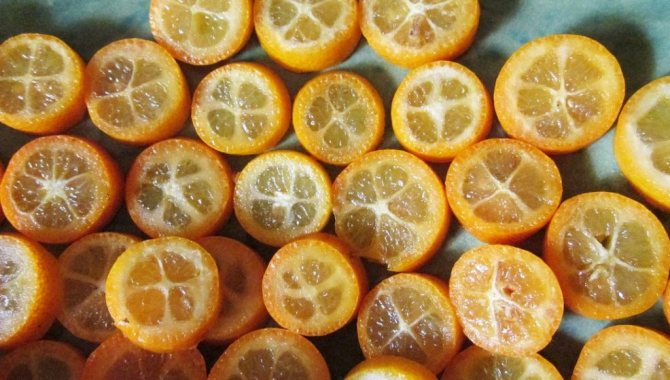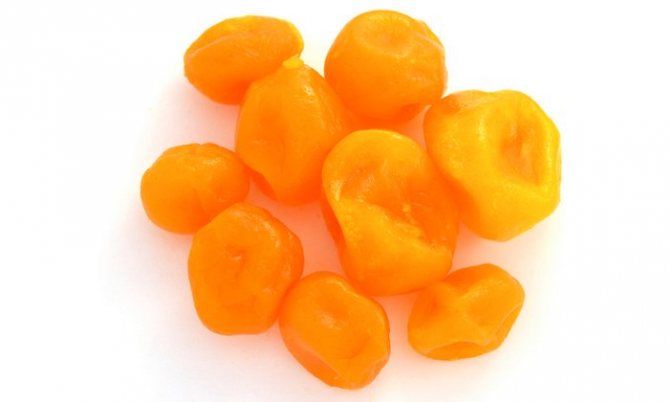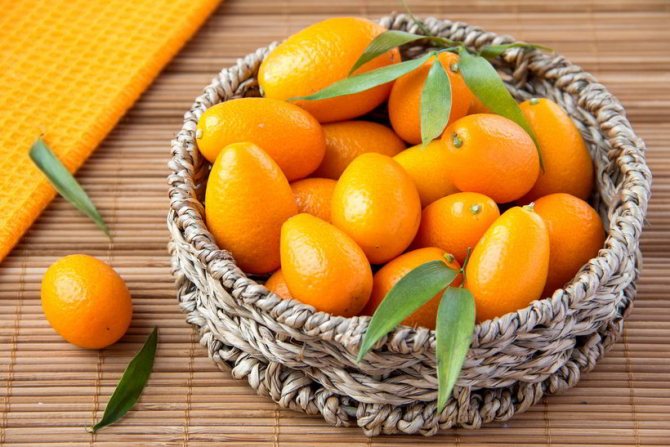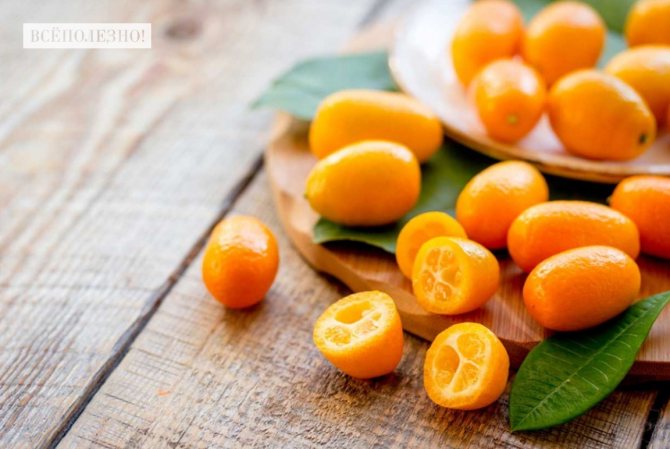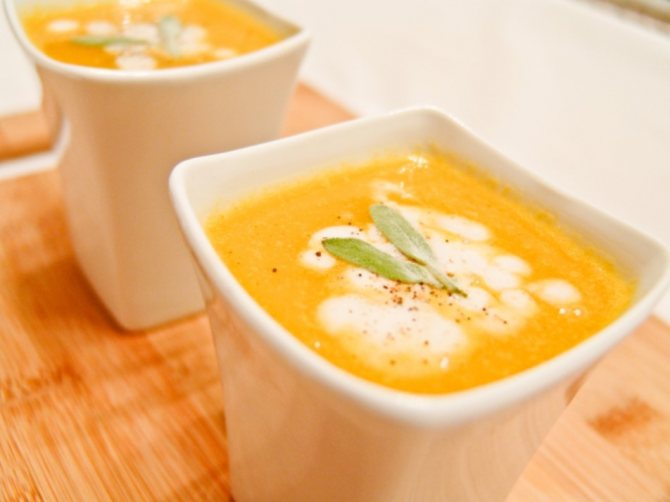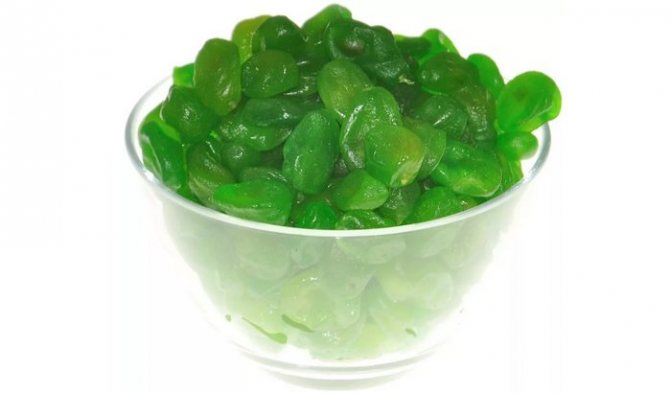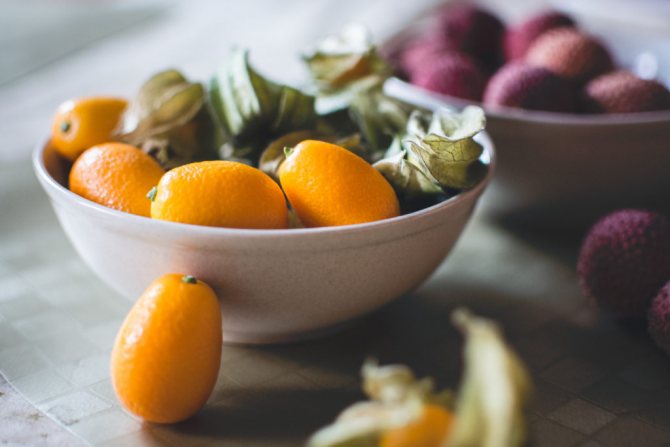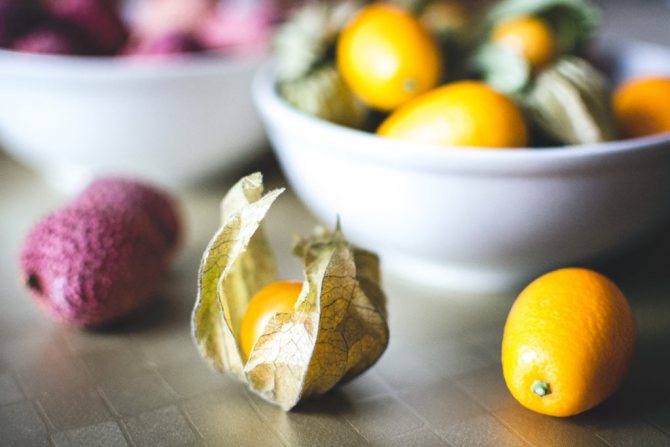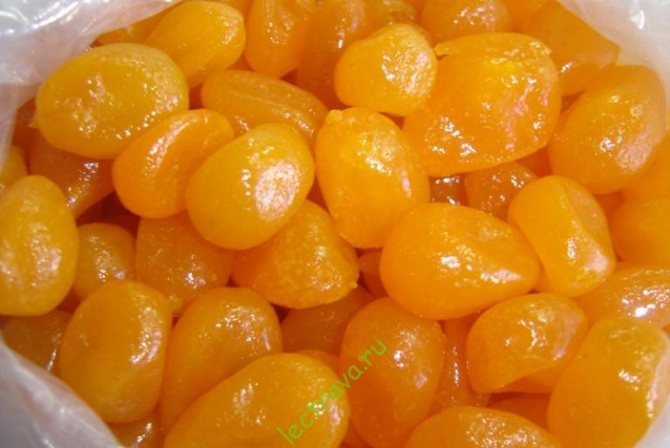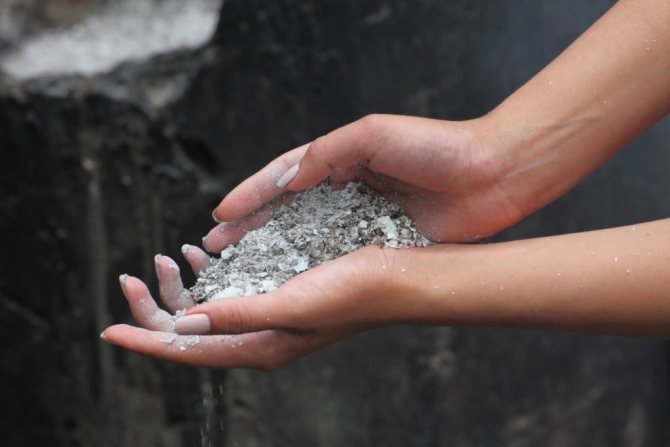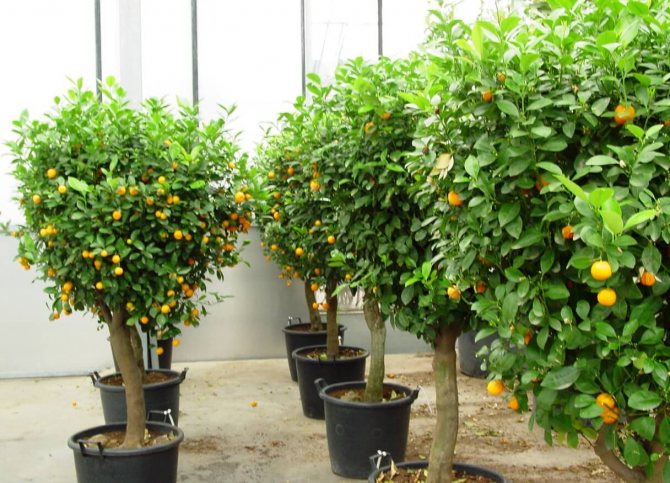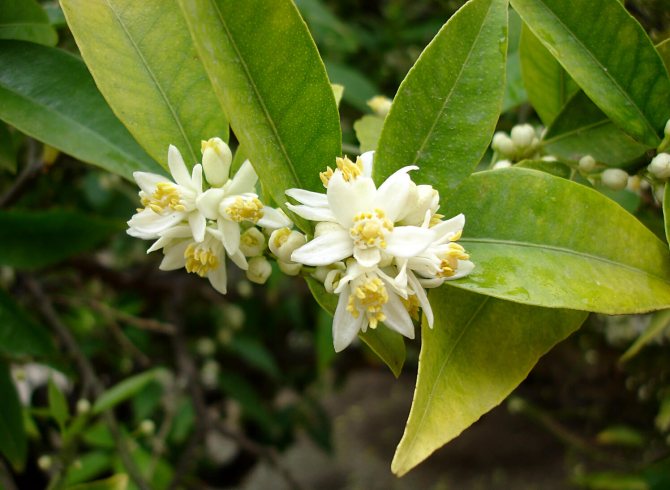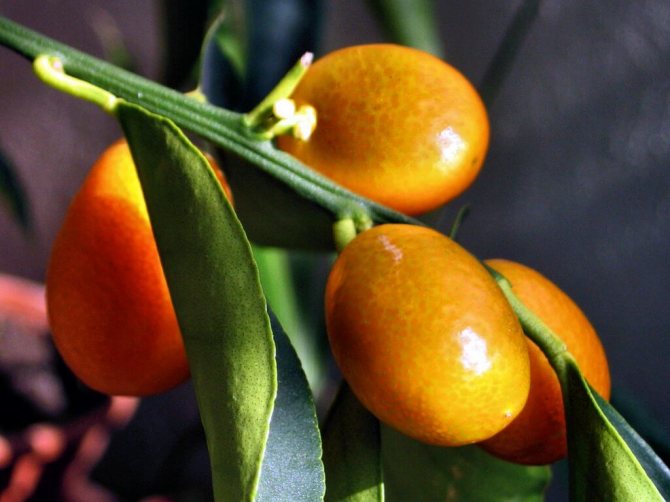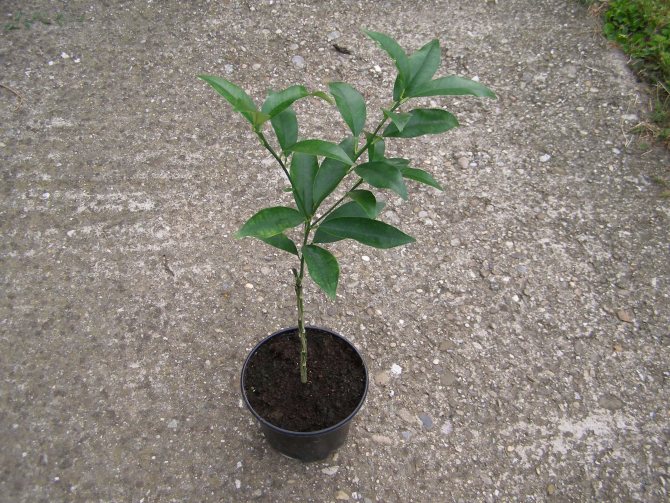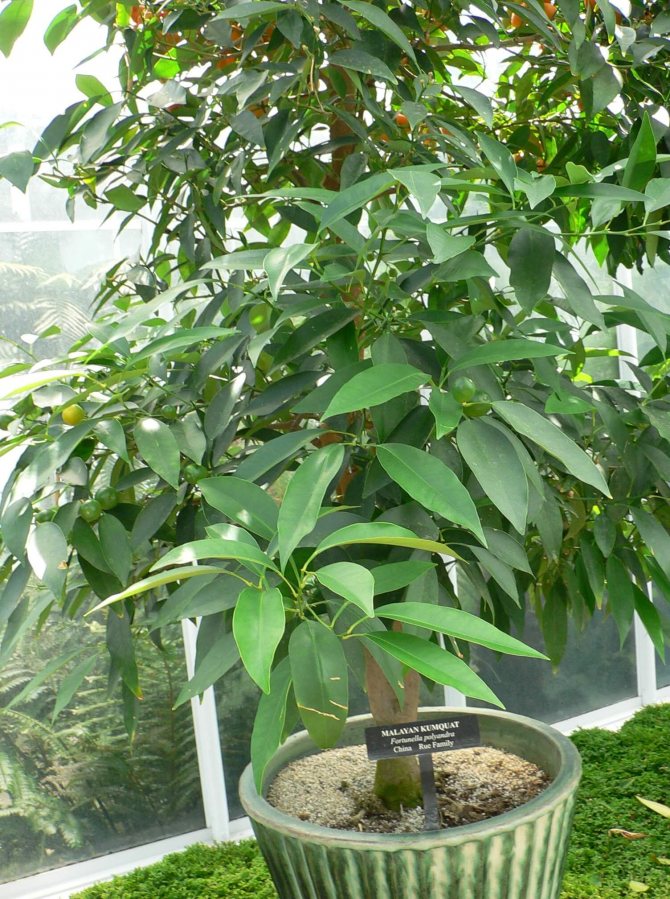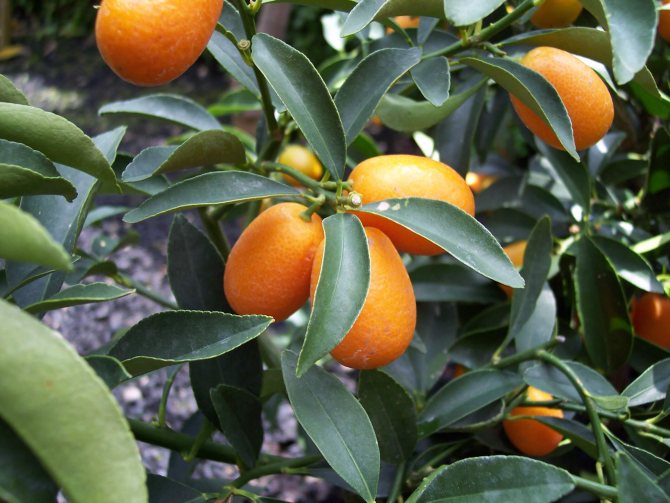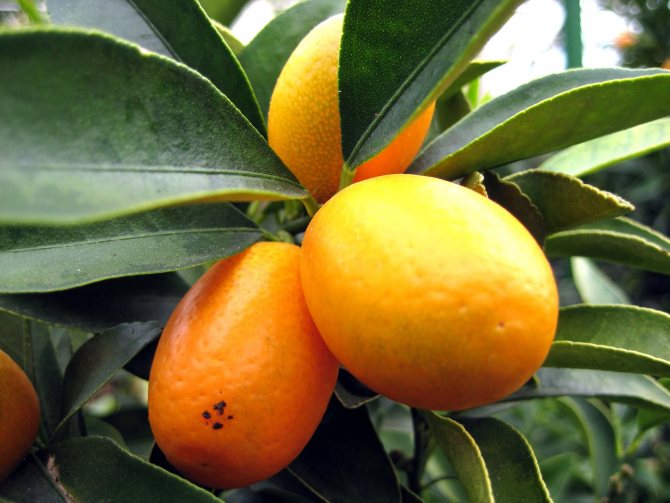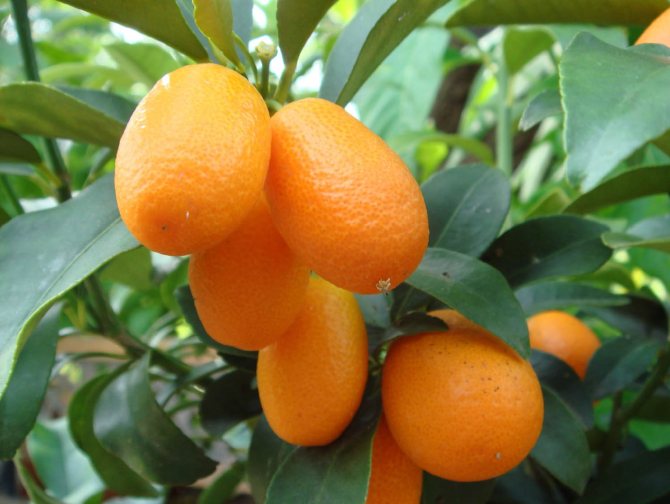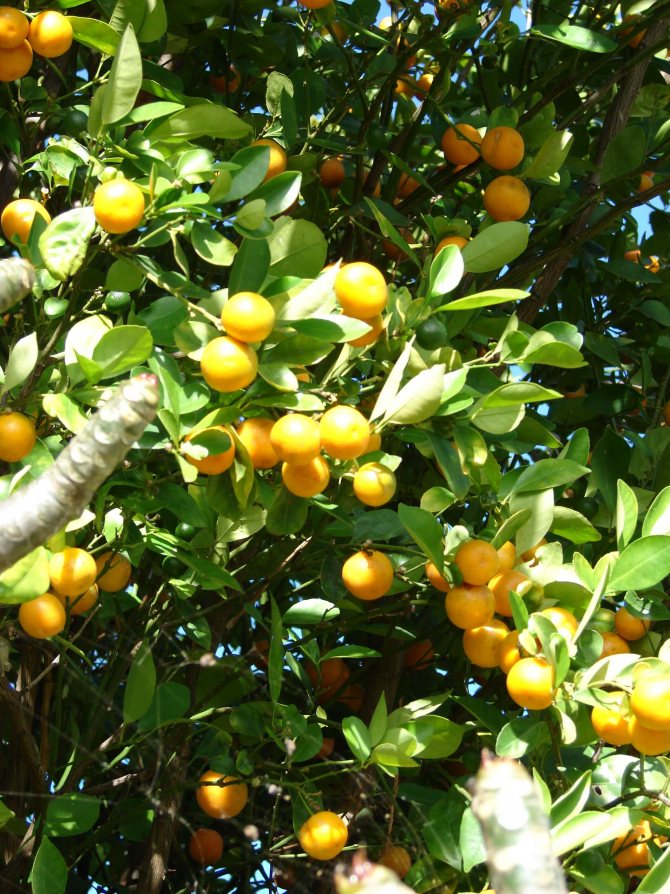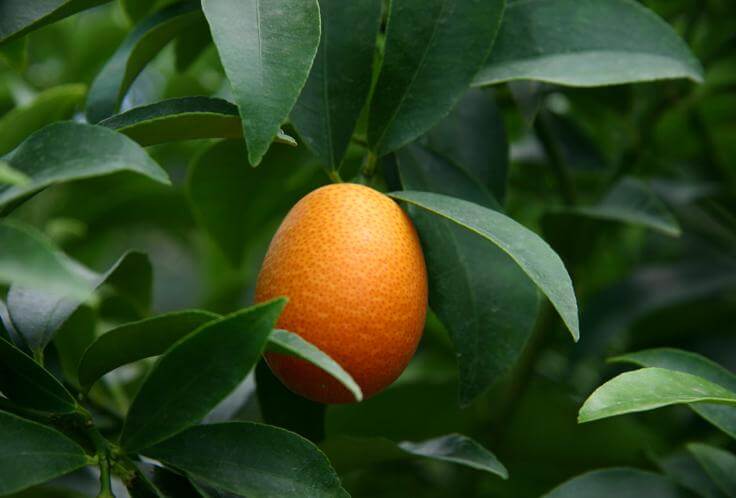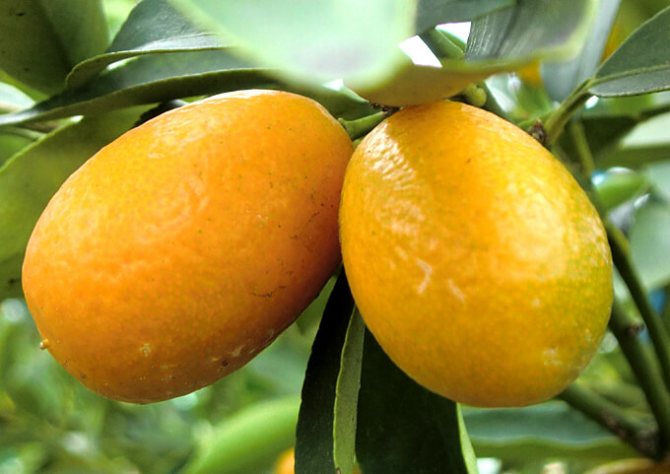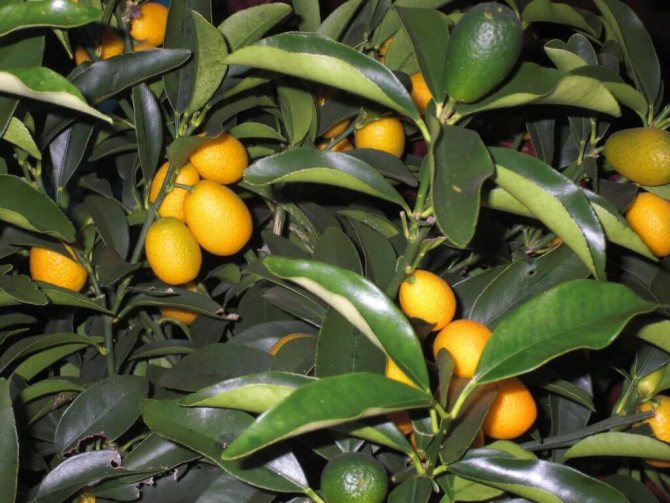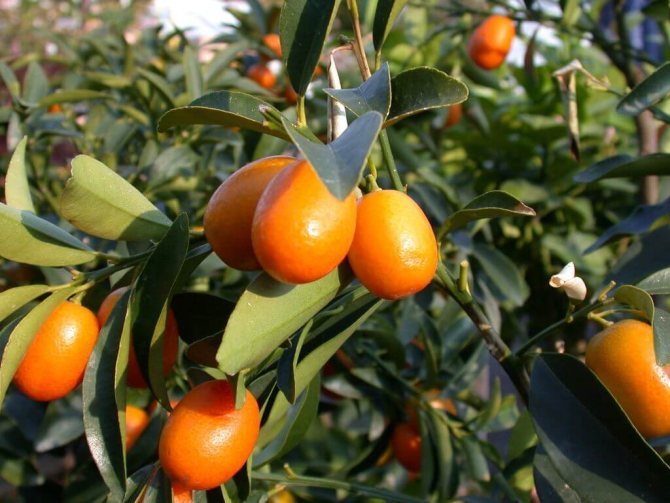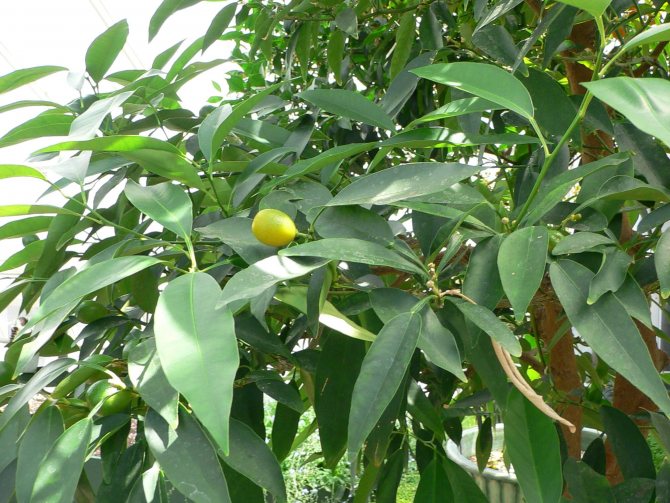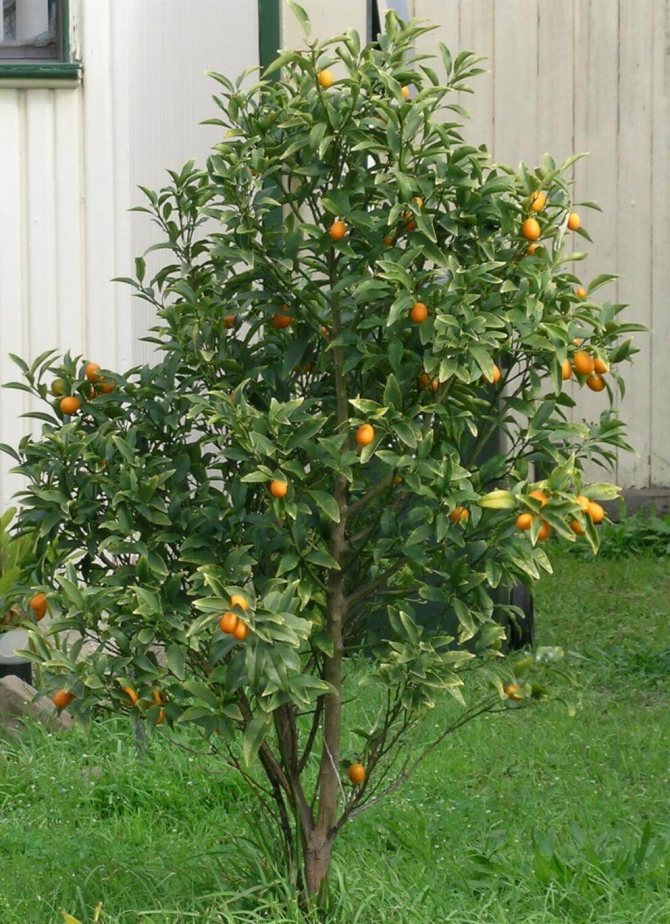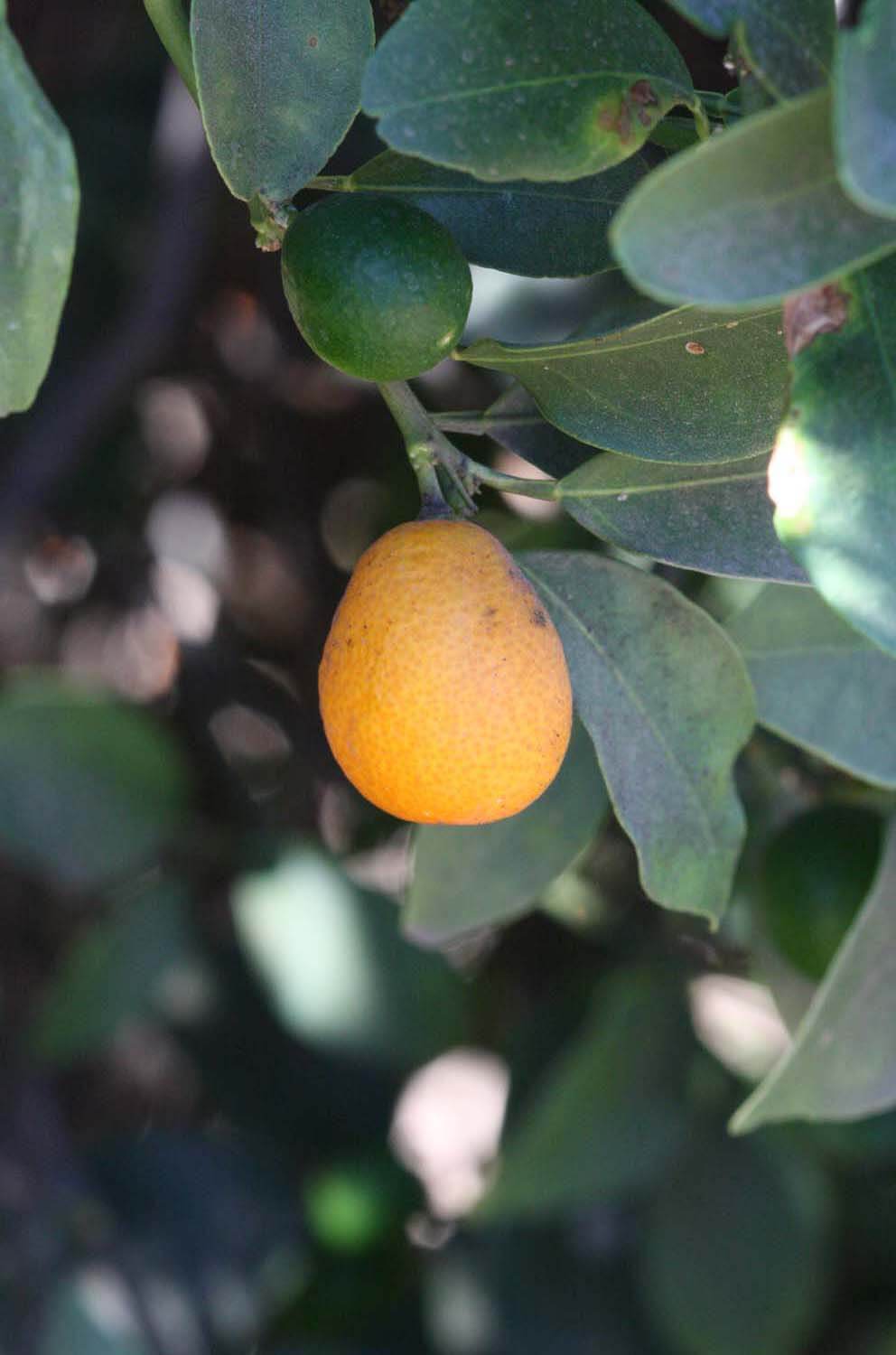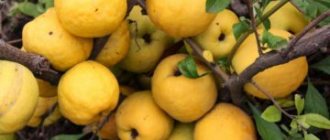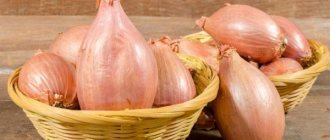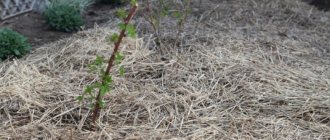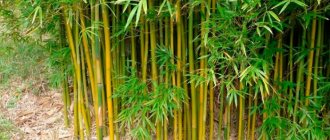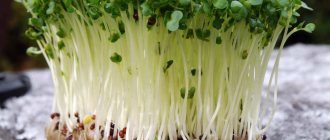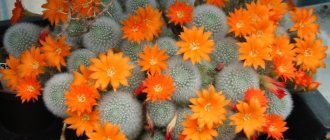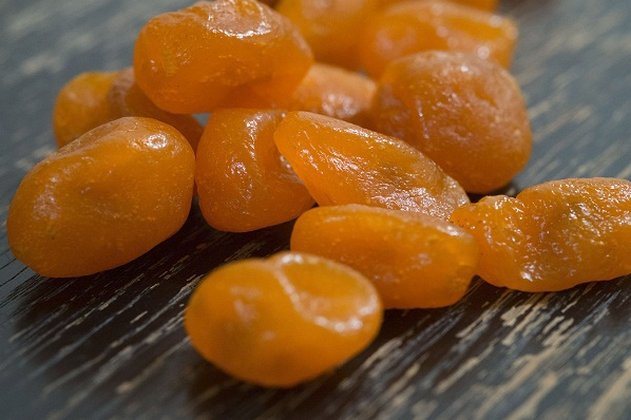
Kumquat is a fruit native to Southeast Asia, belongs to the citrus family. A small fruit, the size of a large apricot, has a lot of useful properties. Quite a long time ago, the Chinese found out that dried fruit is not much different from freshly harvested by its properties. Currently, on the shelves of fruit shops, you can find beautiful slides of red, yellow and even green: all this is dried kumquat, which will be discussed in this article.
- Calorie content and chemical composition
- Beneficial features
- How they eat
- Contraindications and harm
What is a kumquat and where does it grow
The fruit belongs to citrus fruits, it grows on a small tree reaching a height of 4.5 m, but most often it does not exceed 2.5 m.The citrus fruit is native to Southeast Asia, or rather China, but it is cultivated in Greece, in the south of the United States and Japan.
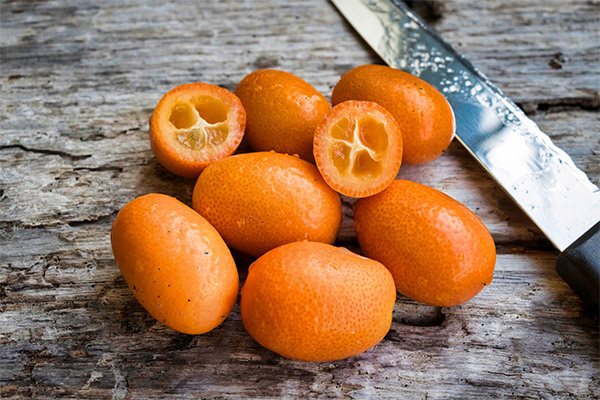

The fruit of the kumquat is bright yellow, the leaves are ellipsoidal, dark green in color. Since the plant is dormant for a long time after wintering, it blooms only in the middle of summer for several days. Repeated flowering often occurs.
The fruit looks very much like a small orange, very juicy, sweet in taste, with a slight sourness, like a tangerine. The fruits ripen at the end of the year.
Views
Kumquat is the smallest citrus fruit and is called differently in different countries. However, most often - "golden apple" (this name was given to him by the Chinese), the official name is fortunella.
The plant has several popular species, which will be discussed below:
- Nagami.
Also referred to as Fortunella Margarita. This is perhaps the most popular species that can be found commercially in almost every major city. The plant looks like a large shrub or small tree. It blooms with white flowers and bears fruit all year round. Can tolerate frost, grows rather slowly, prefers acidic soil. It can even be grown in an apartment. In winter, watering is moderate, in summer - plentiful. - Nordmann.
This type of kumquat is very similar to Nagami, it is also called Nordmann Seedless. From the name, we can conclude that its distinguishing feature is the absence of seeds. The plant is very rare, it is grown only in California, USA. It tastes similar to Nagami, but somewhat different in form. The plant also blooms in summer and is harvested at the end of winter. It can also be used for interior and courtyard decoration. - Malay kumquat.
It got its name from the fact that it grows mainly on the territory of the Malay Peninsula. The plant is usually used for decorative purposes, for example, it makes an excellent hedge. The fruits are the largest of all types, but they have a lot of small seeds. Does not tolerate low temperatures. - Meiva.
The fruits of this type are very tasty, they are recommended for fresh consumption. It is believed to be a natural hybrid of Nagami and Marumi. The fruit is somewhat reminiscent of a large lemon. Also blooms in summer, bears fruit in late winter. There are very few seeds in the fruit, in some there are almost no seeds at all. Although not as frost-resistant, it is still able to withstand low temperatures. - Hong Kong kumquat.
This very small and thorny plant only grows on Hong Kong Island and a small surrounding area.The fruits are bright orange in color, very small, rarely exceed 2 cm, they are not eaten. The plant is used only as a seasoning, since the fruits are not juicy and with large grains. - Fukushi.
It is also called Obawata or Changshu. It is this type of kumquat that is best suited for growing in the house, it has a lush crown. The fruit is orange in color and looks like a pear, tasty and juicy. - Marumi.
This kumquat strongly resembles Nagami, but with thorns. The fruit is edible, slightly smaller than the Nagami, and has a bright golden yellow color. - Variegated kumquat.
The plant officially appeared in the 90s of the last century and is an artificially bred variety. The closest relative of Nagami, from which it differs in light leaves. The fruits are juicy and sour.
1. Seven Secrets of Success:
| 1. Growing temperature: summer - 18 - 24 ° С, winter - 12 - 14 ° С, a cool dormant period is necessary for the onset of flowering, and also so that the plant is not affected by the lack of light in the autumn - winter time. |
| 2. Lighting: light shade from direct sunlight during the daytime, sunbathing in the morning and evening every day. |
| 3. Watering and humidity: in spring and summer, water in such a way that the top layer of soil 3 - 5 cm thick dries up with watering. In autumn and winter, significantly reduce the frequency of watering if the bush is given a cool dormant period. Once a month, mix a few drops of lemon juice or grains of citric acid into the water for irrigation. Air humidity is high. |
| 4. Features of the: for the onset of flowering, competent formative pruning is needed, and for fruiting - artificial pollination. Timely pinching of the tips of young shoots forces the plant to form lateral stems. |
| 5. Priming: very loose and organic-rich soil with a lot of nutrients and acidic pH. |
| 6. Top dressing: Feed liquid citrus fertilizer every 2 weeks in spring and summer. No feeding is carried out in autumn and winter. |
| 7. Reproduction: seeds - seeds sown in spring, stem cuttings in spring and summer, grafts. |
Botanical name: Kinkan.
Homemade kumquat - family... Root.
Where grows... The homeland of the plant is Asia.
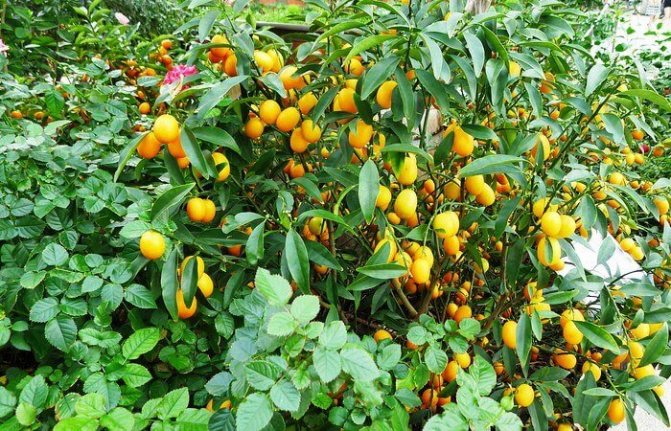

What does a kumquat look like and what is. Kumquat or kinkan or fortunella - evergreen, slow-growing tree 2.5 - 5 m high, stems often have thorns.
Leaves simple, arranged alternately on short petioles, lanceolate, dark green, thick, leathery, glossy, 3 - 8 cm long. The leaf blades have small denticles at the edges, the underside is lighter than the top.
Flowers white, stellate, single or in small axillary inflorescences up to 4 pcs., with a pleasant aroma and 5 wax petals, 1 - 1.5 cm in diameter. Each bush has both male and female flowers, so self-pollination often takes place.
Fruit oblong - oval or round, up to 5 cm in diameter; green, when ripe they become golden yellow, juicy, contain small seeds.
Like other plants of the Rutaceae family, buds, flowers, ovaries, green and ripening fruits can be simultaneously found on the kumquat, which only gives it additional decorative effect.
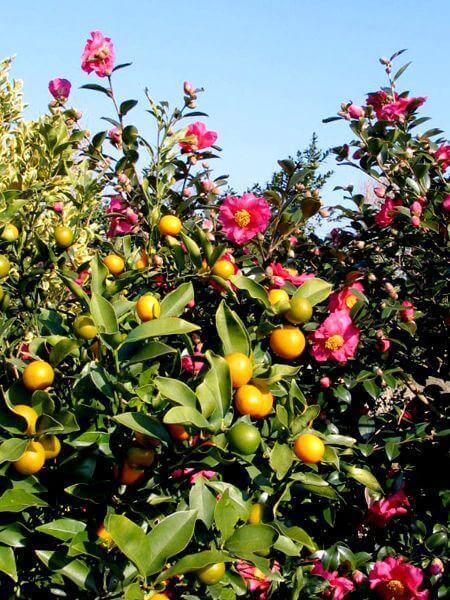

Height... Dwarf kumquat species reach 3m... By trimming, you can maintain a height of 90 - 120 cm.
Composition and calorie content
Kumquat fruits are classified as dietary, since the calorie content of the fruit is only 70 kcal per 100 g.
Energy value per 100 g:
- Proteins - no more than 2 g.
- Fat - practically none.
- Carbohydrates - about 10 g.
The kumquat also contains insoluble dietary fiber. As for the chemical composition, it contains just a huge amount of useful substances: vitamins of group B, C, A and E, lutein, alpha carotene, nicotinic acid, as well as micro- and macroelements: iron, magnesium, phosphorus, potassium, zinc and dr.
Top dressing and fertilization
Without regular feeding, the kumquat will not bear fruit. The frequency of fertilization depends on many factors:
- the age of the tree and its condition;
- used for growing soil;
- the size of the pot.
So, if the pot for the kumquat is small, fertilizing should be done more often.
During the growth period, kumquats are fed every ten days with phosphorus-potassium fertilizers. During the rest period, the amount of dressings is reduced to once a month.
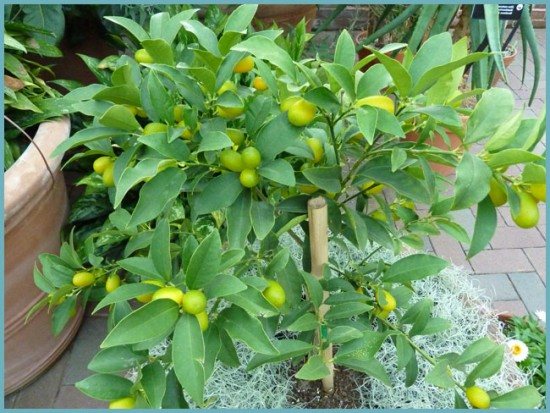

Fertilizers are also essential for fruiting and normal plant development.
The optimal composition of the complex fertilizer (per 1 liter of water):
- ammonium nitrate - 1/4 teaspoon;
- potassium chloride - 1/8 teaspoon;
- simple superphosphate - 1/2 teaspoon.
Kumquat is also responsive to infusion of wood ash.
Useful properties of kumquat
For women
There is no woman who does not want to look beautiful. Due to the presence of a large amount of vitamin E, the fruit is especially effective for women. This vitamin is called women's or beauty vitamin, it is even released as a separate drug.
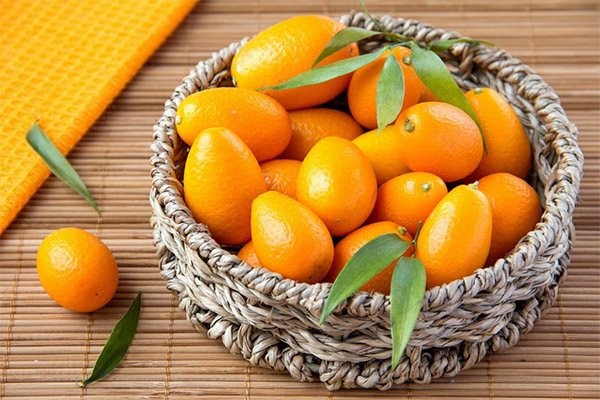

Vitamin E protects the cells of the body from harmful effects and restores them, making the skin beautiful and elastic. It stimulates the formation of protein and new cells. With a sufficient amount of it, the hair becomes soft and fluffy. In PMS, it significantly reduces discomfort and pain.
Vitamin A also plays an important role. It protects the body from viruses and cell aging. It can also be attributed to the group of youth vitamins. It is a natural antioxidant, improves vision and hearing, like vitamin E, promotes rapid epithelial renewal, making the skin healthy and beautiful. In addition, it is an excellent tool for the prevention of cancer. Vitamin A contributes to the production of keratin, the material that forms the basis of hair, so a sufficient amount of it directly affects their growth and strength.
For men
It is no secret that a strong half of humanity is exposed at a fairly early age to various diseases of the cardiovascular system. This is facilitated by many factors: unhealthy diet, lack of physical activity, ecology, heredity, etc. Kumquat is one of the few fruits that can be used as a medicinal product. It prevents the development of most diseases associated with the cardiovascular system.
Junk food contains a large amount of cholesterol, which can trigger many diseases of the heart and blood vessels. It also forms plaques on the walls of blood vessels and coagulates blood, which can be the main cause of stroke. Phytosterols in kumquat have a similar structure, however, they significantly reduce its absorption and remove it from the body.
Do not forget about the gland, which is also abundant in the fetus. This element is extremely important for the body of an adult man. Iron is directly involved in the formation of hemoglobin and hematopoiesis, delivers oxygen to each cell.
During pregnancy
This small citrus fruit will be an excellent source of vitamins and valuable elements for the expectant mother. It should be noted that this is a highly allergenic product, therefore, in the second half of pregnancy, it is necessary to reduce its consumption.
Why kumquat is useful for pregnant women:
- calms the nervous system and improves sleep;
- removes toxins and toxins from the body;
- positively affects the work of the digestive tract;
- normalizes metabolism and lowers blood sugar;
- removes anxiety;
- eliminates constipation due to the presence of fiber;
- increases the protective functions of the body.
Immediately before the birth itself, it is better to abandon the use of kumquat altogether so that the child does not develop allergies.
When breastfeeding
During the period of breastfeeding, the mother has to adhere to a strict diet so that the baby grows up healthy and strong. Although kumquat contains many beneficial elements and vitamin A improves lactation, it should still be eliminated from the diet. As mentioned earlier, the fruit can cause allergies in a child.
Video:
what kind of fruit can a nursing mommy Expand
For kids
As for children, you can give this exotic fruit from the age of 3. But you need to introduce it into the child's diet gradually, gradually increasing the amount.
Why kumquat is useful for children:
- The fruit contains a lot of vitamin C, which is so important for a developing organism, because it helps to increase immunity and participates in metabolism.
- Kumquat contains calcium and phosphorus - building materials for the skeletal system.
- Fiber and other substances regulate the amount of sugar in a child's blood, preventing the risk of diabetes.
- Iron is an important element involved in hematopoiesis.
- Magnesium provides cardiovascular protection.
- The fruit helps to cope with stress, improves sleep, calms the nervous system.
Children need to start giving kumquat with half of the fruit, and over time, bring this amount to several pieces. However, sometimes you need to take a break. After the first dose, you need to closely monitor the state of the child's body. If redness or itching appears, then you should refuse to use it.
When losing weight
Due to its beneficial properties, this fruit is often included in diets. Kumquat has a positive effect on metabolism, speeding it up and removing excess fluid. Insoluble fiber quickly saturates the stomach, thus satisfying hunger. In addition, they remove toxins and food debris that are the cause of excess weight.
It is also worth mentioning that the product is very low in calories, so it is impossible to gain weight while consuming it. Experiments have shown that with regular use of kumquat per month, you can lose from 2 to 8 kg without resorting to a special diet.
When composing a diet menu, you should not give preference to one kumquat. Along with it, you can eat many other foods, but you should avoid foods containing a large amount of fat, as well as give up sweets and limit the consumption of flour products.
As for dairy products, they should be with a low percentage of fat. The advantage of kumquat is also the fact that it contains many useful elements and vitamins that are so necessary when restricting nutrition.
Diseases and pests
Kumquat is affected by a variety of citrus diseases. Trouble symptoms can include:
- spots on the leaves;
- change in the shape and color of leaves;
- paniculate shoots;
- drying out of the tree;
- the formation of growths.


Spot on kumquat leaves
Fungal and bacterial diseases (anthracnose, wart, gommosis, etc.) can be cured. If there are buds or fruits on the plant, they must be removed to save the strength of the kumquat. Further, repeated treatment with fungicides is carried out. During this period, it is important to properly care for the tree, restoring its vitality.
Advice. To prevent the development of fungal and bacterial diseases, kumquat can be treated with 1% Bordeaux mixture solution 2-3 times during the growth period.
A tree infected with a virus (xyloporosis, trispeza, etc.) cannot be cured.
In an unfavorable indoor climate, kumquats are attacked by aphids, spider mites, scale insects and other sucking pests, which are controlled with special preparations.
The benefits and harms of dried kumquat
Since ancient times, people have tried to preserve some products for a long time - this is how they began to dry certain fruits. Dried kumquat has recently appeared on the market, it is small in size, about the size of a walnut, it can be red, yellow or green. By the way, the tradition of drying citrus fruits supposedly originated in China, on the territory of modern Guangzhou.


Dried kumquat is an underrated fruit that has been used as an adjuvant in the treatment of many diseases. Its regular use in food is the prevention of gastrointestinal diseases.Dried kumquat retains almost all nutrients and vitamins, so it can easily take the place of expensive vitamin complexes. It perfectly replenishes the lack of minerals and vitamins, removes salts of heavy metals, improves immunity, normalizes stool and metabolism.
Even in ancient China, dried kumquat was successfully used to treat colds, runny nose and coughs. It contains many essential oils and substances that have antifungal and antibacterial properties. It is dried kumquat that is an excellent tool for cleansing the gastrointestinal tract, lowering cholesterol and removing toxins and toxins. To feel the improvement, it is enough to eat 5-7 fruits in the morning.
Talking about the dangers of dried kumquat is somewhat wrong, because the fruit cannot cause direct damage. However, like all foods, it should be consumed in moderation. You should also pay attention to individual intolerance.
Kumquat is a dietary product, but do not forget that it contains a lot of carbohydrates, which can add extra pounds to those who are obese or tend to be overweight. Citrus fruit can cause harm to those with kidney problems, because when removing poisons and toxins from the body, it drives them through natural filters and causes complications.
We advise you to read:
dried kiwi: benefits and harms
To read
Where does kumquat grow?
What is kumquat is well known in Southeast Asia, Japan, China, the Middle East, where this culture occupies large plantations, and also grows wild.
In Europe, the fruit is called the "Japanese orange", in China and Japan, the "golden orange".
Kinkan loves sunlight and grows well in hot, humid climates. The most comfortable air temperature for its development is 25-30 ° С. However, in extreme heat with a lack of moisture, the plant sheds its leaves.
We suggest that you familiarize yourself with: What sub-zero temperature does cauliflower withstand?
Why is dried kumquat useful?
One of the ways of harvesting the fruit is drying, in which it is cooked. Considering that the fruit is 80% water, then when dried it decreases in size several times and becomes very small.
Dried kumquat contains the same amount of vitamins and minerals as fresh, therefore it can replace any complex of vitamins. Useful properties of dried kumquat;
- is an excellent antifungal and anti-inflammatory agent;
- improves intestinal motility and stomach function;
- enhances immunity;
- removes toxins and toxins;
- reduces the absorption of cholesterol by the body;
- counteracts cell aging;
- improves vision and helps in the treatment of the retina of the eye;
- helps with weight loss;
- calms the nervous system, promotes quality sleep and improves mood;
- effectively fights hangovers.
What kind of fruit?
Kumquat is a citrus. This fruit, which looks like a small orange in the shape of a torpedo melon, grows in China, Japan and India. The fruit is about 5 cm long and 4 cm wide. In general, everything is the same as with ordinary oranges, but there are still a number of differences. Kumquat is oval. Moreover, its rind is thick and edible, even sweet. Therefore, the fruit is eaten with the peel. There is not as much pulp as that of an orange. The color can range from yellow to bright orange depending on the variety. Its taste is similar to that of mandarin. The juice can be bitter, so it is worth kneading the fruit with your fingers, removing the juice.
However, the taste and color depends on the conditions, the place where the variety is grown. The taste can be slightly bitter, sometimes cloying. But more often than not, sweetness is expected.
The fruit is not very old, its history begins only from the 18th century. The tree on which it grows, on average, reaches a height of 3-4 meters. Branches with fruits can be protected with thorns.
The use of kumquat in medicine
Today, kumquat is included in the list of fruits and plants that have significant healing properties. In the vastness of the former CIS, this citrus fruit is known relatively little, but in Asia it is widespread and used in folk medicine for the treatment of many diseases.
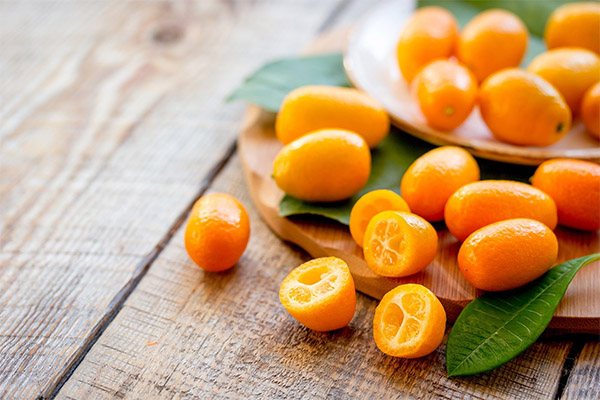

- Kumquat contains many more vitamins and nutrients than any citrus fruit on the planet. It is especially appreciated for its high content of vitamin C, which provides the body's resistance to most viruses and improves immunity.
- Also, kumquat does not accumulate nitrates, which is especially important when used as a concomitant drug. Regular consumption of this fruit, both fresh and dried or dried in the midst of an epidemic of viral diseases, will help protect against them.
- In eastern traditional medicine, kumquat is used to treat ulcers and diseases of the duodenum. It is prescribed as an adjuvant for disorders of the gastrointestinal tract, in particular for constipation.
- Regular consumption of citrus fruits is a guarantee of a strong nervous system, good sleep and excellent mood. Due to the fact that it perfectly removes toxins from the body, it is advisable to use it for a hangover. After consuming only 200-300 g of this fruit, nausea and headache will go away, the stomach will begin to work, and the general condition will improve.
- Nutritionists recommend using kumquat for obese people, as it increases metabolism and activates metabolism, which is important in the treatment of the disease.
History of the kumquat
Scientifically known as Fortunella japonica, this fruit belongs to the Rutaceae family, in the genus Fortunella, and is named after the botanist Robert Fortuna, who brought it from China to Europe in the 19th century. Then the fruit was referred to as "the little pearl of the citrus family." Kumquat is also known as "cumquats" and the name is taken from the Cantonese word, pronounced "kamkwat" which means "gold" or "gold", "orange" or "mandarin". This citrus is native to southern China.
The fruit was described in China as early as 1178 AD. A European writer in 1646 referred to this fruit from a description of a Portuguese missionary who worked for 22 years in China. In 1712, the fruit was added to the list of plants that are grown in Japan.
In the 19th century, cultivation began in Europe and North America as potted specimens in courtyards and greenhouses. Nowadays, kumquats are grown mainly in California, Florida and Texas; to a lesser extent in Puerto Rico, Brazil, Guatemala, Suriname, Colombia. In South India, trees can be easily seen at high altitudes. There is limited cultivation in both Australia and South Africa.
Kumquat in cosmetology
Eating the fruit is beneficial for the general condition of the body, while in cosmetology, oil from kumquat seeds is used. When combined with other oils, it works well for stretch marks and is used to heal scars. Just 3 drops added to the body cream will help to smooth the skin and make it smoother.
Also, kumquat seed oil is used to cleanse oily skin and give it elasticity. Regular use will help you always look fresh and well-groomed. For this purpose, you can add 2 drops of oil to the cream or to the base oil (almond, macadamia, coconut) and use it overnight.
Kumquat seed oil can be added to any cosmetic product. It is gentle and delicate, it contains a lot of vitamin A, which contributes to the production of collagen, which protects the cells of the dermis from the effects of free radicals.
Video:
6 Rescue Masks for Perfect Facial Skin Expand
Breeding kumquat
There are several ways to propagate a kumquat:
- seeds;
- cuttings;
- rooting of cuttings;
- inoculations on rootstocks.
Grown from seeds, young plants do not retain their maternal qualities, they begin to bear fruit late. This method is mainly used by breeders for breeding new varieties and growing rootstocks.


Kumquat seedling
At home, propagation by cuttings is most acceptable. Cuttings are cut in the spring, picking up short young shoots of the last year on a fruiting kumquat. The leaves are cut in half. Cuttings are rooted in wet sand, covering the container with glass or film. An impromptu greenhouse is opened from time to time to ventilate the seedlings.
Rooted cuttings are planted in pots with soil. Further care of the seedling is carried out as for an adult plant.
It is quite possible to grow a kumquat at home, providing it with proper care. As a result, you will receive not only an elegant decorative tree, but also tasty, healthy fruits.
Tags: kumquat, description, variety
About
«Previous post
Harm and contraindications
As noted earlier, talking about the dangers of kumquat is inappropriate, the fruit cannot harm the body. However, you need to understand that the fruit is exotic and you need to treat it carefully, gradually introducing it into the diet. Kumquat, like all citrus fruits, is a highly allergenic product, so allergies to it or individual intolerance are quite common.
It can also cause problems if you eat a lot of it. The fact is that citrus has a low calorie content, which means that it is very easy to eat too many fruits. This can lead to diarrhea, flatulence and bloating.
A high amount of carbohydrates can be a problem for diabetics, but this does not mean that they should not eat it. You also need to be careful with the fruit in case of acute gastritis and exacerbation of stomach ulcers. It is not recommended to use it in the diet for people with kidney and genitourinary system diseases, as it creates an additional burden on them.
During pregnancy and lactation, it is imperative to consult a specialist before use. If this is not possible, it is better to refuse to use.
About the dangers of fruit
As we said earlier, great care must be taken when consuming kumquat, especially for pregnant women. The reason for this is a possible allergy. Since the fruit is a citrus and, like its brothers, citrus is a strong allergen.
If there are stomach diseases in the form of ulcers, gastritis, inflammation, or you suffer from high acidity, it is better to communicate with the fruit on "you". It is better for your own good to abstain.
Also, with inflammation of the genitourinary system, the product is prohibited. For example, with cystitis. To provoke - will not provoke, but it will provide complications!
If you are the type of person who gains weight quickly or has diabetes, then it is better to set aside dried kumquat, as it contains a high calorie content. You can eat, but again, keep track of the amount, if you do not want to return to your problems.
How to choose and store a kumquat
Like all citrus fruits, buying and storing kumquats must be correct. When purchasing a product, you need to pay attention to the following:
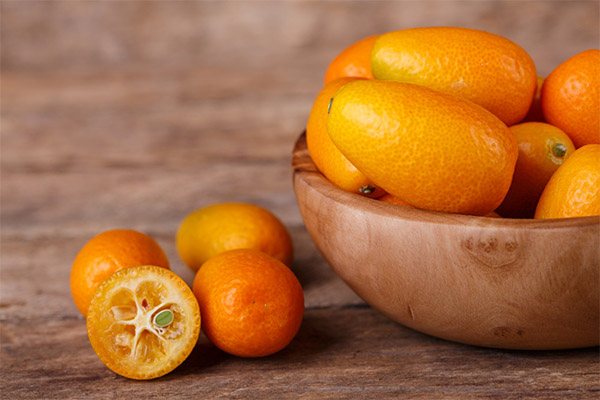

- The color of the kumquat should be rich and expressive. Although many advise you to choose only orange fruits, you need to pay attention to the variety, since there are both light green and yellow kumquats.
- The rind should be smooth and shiny.
- The kumquat should be moderately firm. So, too soft a fruit means that it is overripe, therefore it cannot be stored for a long time, and too hard is unripe.
- There should be no damage to the skin.
As for storage, contrary to popular belief, if you create suitable conditions, then even outside the refrigerator, citrus can lie for a very long time. However, in an apartment, it should not be stored for more than 4 days.In the refrigerator, the fetus can remain unchanged for up to 3 weeks.
The kumquat season starts in November and ends in spring, when the largest selection on store shelves. To eat it all year round, the fruit can be frozen, dried, or dried. Freezing a kumquat is very easy, even at home.
How much is a kumquat
The average price for fresh kumquat in supermarkets and in the markets of Russia and the CIS ranges from 625 to 1000 rubles per kilogram. The cost of dried or dried from 300 rubles per kg.
We advise you to read:
how to choose ripe mango in the store
To read
Description of the plant
Kumquat is a small evergreen tree that is 2.5 to 4.5 meters high. The branches are angular and compact when the tree is young, and older with several thorns. The tree grows in hot climates and generally prefers moist soil that is rich in organic matter. Leaves are oval, even elliptical, of medium green color, with a sharp apex to the south and a tapering blunt base.
Flowers are single, white, bisexual; sepals 5-toothed, oblong petals. Although many kumquat trees are grown for their rather sweet, tasty fruits, they are also used as ornamental plants with delicate white flowers in summer.
Kumquat fruit
Kumquat is beneficial for many aspects of health. They are actually tiny citrus fruits. They are usually spherical, slightly flattened 2.0-2.7 cm in diameter, 5 cm long. The fruit turns orange when ripe.
The fruit consists not only of tasty flesh, but also a rather sweet, thin, fragrant outer rind. The flesh is fleshy with 4-6 slices, juicy like orange slices. Although kumquat tastes similar to other citrus fruits, it differs in that it can be eaten whole, including the peel, and some people, on the contrary, are even more fond of the peel.
The fruit may contain 1-3 small pointed seeds, or it may not even have seeds. The fruit has been used as a food product since ancient times.
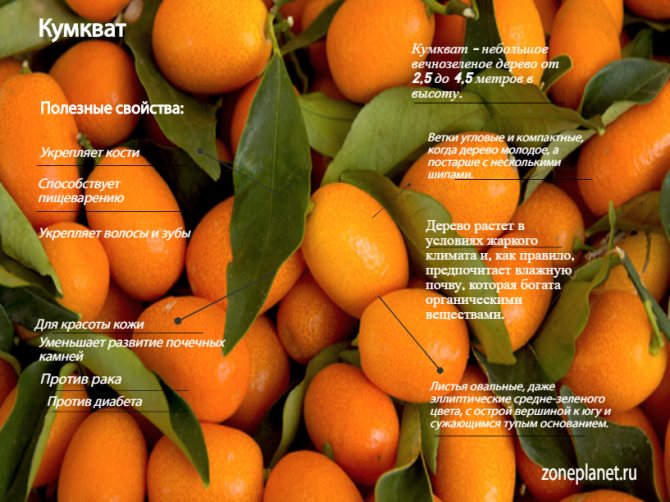

How to eat kumquat
How much can you eat per day
As for the quantity, this is a rather individual question. Usually it is recommended to consume no more than 300 g per day, it is undesirable to eat more. In addition, the ability of the fetus to remove toxins and toxins can create an increased burden on the kidneys and the genitourinary system, which will negatively affect the state of health. It should also be borne in mind that this is not a "native" fruit, so you need to treat it carefully.
Can I eat with the peel
Kumquat not only can be eaten with its peel, but it is also necessary. It is the only citrus that has this trait. Also, it is the peel that contains a number of substances that are excellent at fighting against fungal infections, and are also natural antiseptics.
Basic rules for growing
The plant, like all citrus fruits, is difficult to reproduce by seed, has the same pests. Therefore, the number of golden oranges increases vegetatively, by root division.
To resist citrus fungi and other diseases, a three-leaf poncirus is planted with kumquat. This shrub has excellent resistance to harmful bacteria. It scares them away not only from themselves, but also from the neighboring kumquat.
It's important to know! For irrigation, it is better to use rain, melt or river water. Chlorine in tap water is harmful to the plant.
The ideal temperature for growing is +15 degrees. High air humidity, an abundance of ultraviolet rays are factors affecting the rapid growth of the shrub. The plant should be planted in humus mixed with sand. The optimum soil Ph ranges from 5.5 to 7.
Kumquat is a small citrus that is of great benefit to the body, taste buds, and mood. Regular consumption of the dwarf fruit significantly improves health and quality of life.
What can be made from kumquat: recipes
Jam
Making kumquat jam is very simple. It doesn't require any special skills or knowledge in cooking.
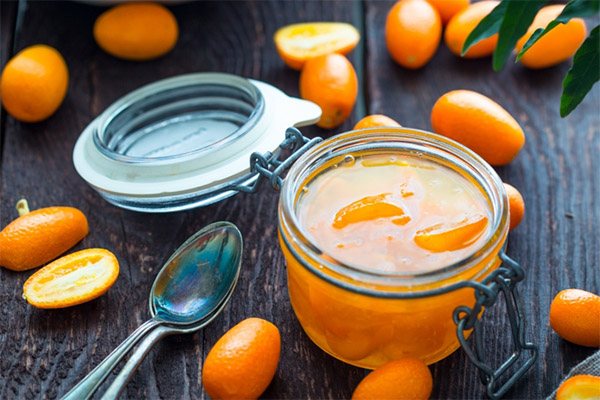

What you need:
- Kumquat - 0.5 kg.
- Orange - 1 pc.
- Granulated sugar - 0.7 kg.
How to cook:
- Kumquat fruits are thoroughly washed with running water.
- Lay on a towel and leave for half an hour to dry thoroughly.
- Then each fruit is pierced in several places with an ordinary toothpick or skewer.
- Peel the orange and squeeze out the juice.
- The juice is mixed with 100 ml of pure water and added to granulated sugar.
- The mixture is heated to a boil and cooked over low heat until a syrup is obtained, stirring constantly.
- The resulting syrup is poured over the fruits, covered with a clean cloth and left for 4-6 hours.
- After that, the fruit, along with the syrup, is again put on the fire, brought to a boil and cooked for 20 minutes.
- The procedure is repeated several times.
- After cooking, the jam is consumed immediately or closed for the winter.
Compote
It is worth noting that the kumquat itself is a fairly versatile product; many desserts can be prepared from it and added to dishes. As for the compote, from these citrus fruits it turns out to be quite sour, so it is better to add other fruits.
What you need:
- The citrus itself is 50 g.
- Strawberries - 100 g.
- Sweet cherry - 50 g.
- Water - 2–2.5 liters.
- Sugar - 3-4 tbsp.
How to cook:
- To begin with, prepare the kumquat: wash it in hot water and cut it in half.
- Cherries are sorted out, throwing out the rotten and removing the tails. Do the same with strawberries. If it is large, then it is better to cut it.
- Bring the water to a boil, add sugar, stir thoroughly, reduce the heat.
- After 10-15 minutes add all the fruit and cook for 1 hour, stirring occasionally.
- When the compote has cooled down, it is stored in the refrigerator or served to the table.
We advise you to read:
what can be made from avocado
To read
Candied fruit
What you need:
- Kumquat - 10-15 pcs.
- Granulated sugar - 1 glass.
- Water - 1/2 cup.
How to cook:
- Citrus fruits are thoroughly washed.
- Then they are cut across, approximately 0.5 cm thick, and the seeds are removed.
- A syrup is prepared from water and sugar.
- Pour the chopped kumquats over and leave for an hour.
- Then the syrup is drained and the blanks are laid out on parchment paper.
- Preheat the oven to 180 ° C.
- Put the baking sheet in the oven and bake for about an hour, then take it out, turn the slices over and return it to the oven for 10-15 minutes.
- After cooling, candied fruits are laid out in containers, so it can be stored for several months.
Kumquat tea
Ice tea is especially tasty.
What you need:
- Black tea bag.
- Several mint leaves.
- Kumquat.
- Honey.
How to cook:
- The tea bag is brewed in the usual way.
- Then add a few leaves of mint or lemon balm, let stand for a few minutes.
- After that, cut the kumquat and put a few slices in the tea.
- Allow to cool, add honey to taste.
Video:
kumquat tincture recipe Expand
Planting and caring for kumquats
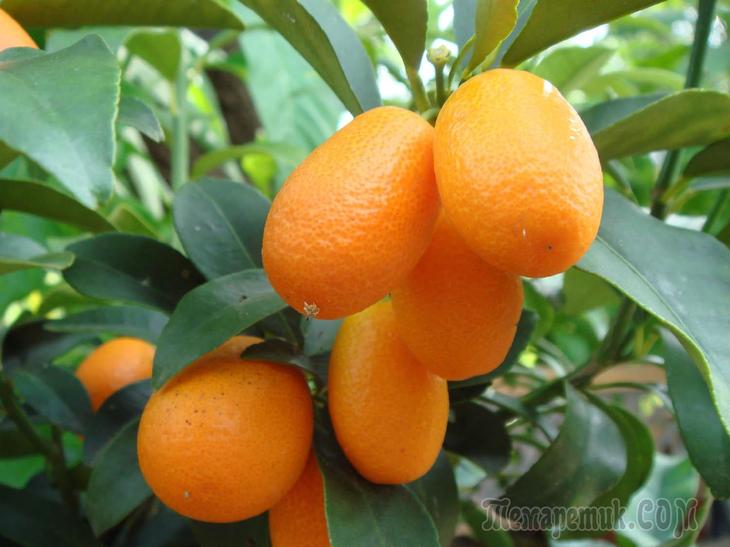

The growth period of the kumquat lasts 1-2 months, starting in April. The annual growth is up to 10 cm. A young plant gives two growths per year, which distinguishes the kumquat from other citrus fruits. The tree blooms in the middle of summer for a week. Flowering can occur again after 2-3 weeks. At home, the flowering of the tree needs to be normalized. By the end of winter, exotic fruits ripen on the kumquat.
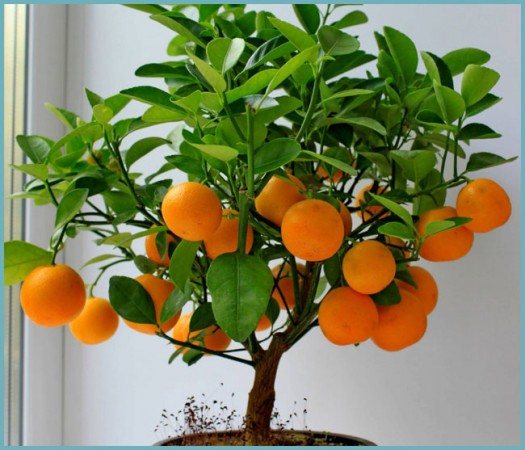

With proper care, the tree will bear fruit in winter.
Location. Kumquat needs to be given the sunniest spot in the house In the summer - create conditions for diffused lighting, you can take it out to the street or balcony. In winter - as much direct sunlight and, if possible, cool air.
The soil. For planting kumquat, a soil mixture of sod and garden soil, leaf humus and river sand is used.
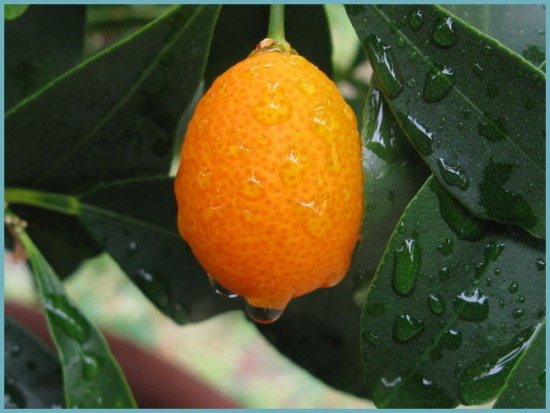

Water the kumquat abundantly
Watering. Kumquat loves watering very much. They should be abundant and regular, without stagnant moisture.In the summer heat and the period when central heating is on, the plant needs frequent spraying and wiping the leaves with a damp cloth. With excessively dry air, the tree begins to ache and shed its foliage. It will also be useful to "shower" with a kumquat, imitating natural rain.
Attention! Watering should be done only with warm water. Otherwise, the tree will shed its foliage.
Pruning. Spring is the period of kumquat crown formation. For this, 2-3 shoots are left on the main branches, the rest are removed. The shoots left are shortened slightly, thereby stimulating the growth of young shoots.


Transfer. Once every two to three years, the plant needs a transplant. They do this by transshipment so as not to disturb the earthen lump. The soil and drainage layer in the pot must be changed to new ones.
How to dry a kumquat
You can also dry kumquat at home. Of course, you can buy it in the store, but isn't it more interesting to cook it yourself? In this case, there is no need to doubt the quality of the kumquat and its usefulness. By the way, lemons are often dried along with this citrus. It turns out a very tasty product that can be stored for a long time and enjoyed the whole winter.
To make dried kumquat at home, you can follow our guidelines below:
- First, prepare all the necessary products, namely the kumquat. You need to take the amount of citrus that you plan to dry. Do not take too many fruits, as they may deteriorate. Rinse and cut into quarters.
- The next step is to decompose the fruit in an electric dryer. An important condition is that the electric dryer must be absolutely clean, there must be no third-party odors in it, otherwise they can be absorbed into the kumquat. Spread out so that there is a small distance between the pieces.
- Switch on the dryer. Set the temperature to 135 ° C. Dry the kumquat for 6 hours. The fruit will shrink and become drier.
- After drying, put in bags. Store dried kumquat in a dry, dark place for about two months, no more.
We advise you to read:
how to dry melon
To read
Honey infusion with dried kumquat
- Take 10 pieces of Dried Kumvat.
- Cut each piece with a sharp knife (this is necessary to maximize the extraction of nutrients from the fruit), then place them in a glass jar.
- Peeled ginger root (about 50 g) is added there, as well as 500 ml of honey and vodka. Close the jar, shake well to mix the ingredients, and refrigerate for three months.
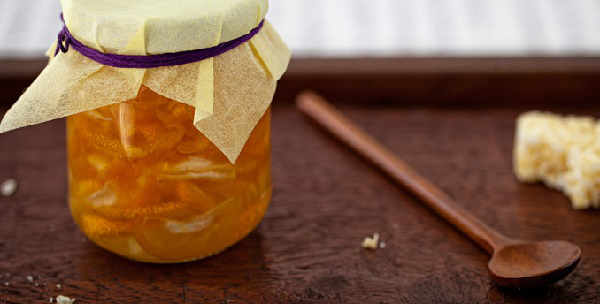

This tincture is used as a vitamin-tonic supplement to reduce blood pressure and improve the functioning of the gastrointestinal tract (if there are no contraindications). You need to drink the tincture three times a day before meals, one tablespoon. When treating a cough, the scheme is different: the agent is slightly heated and drunk at night in small sips (100 ml).
Today, information was described about an extraordinary tropical dried fruit - dried kumquat, useful properties and contraindications. The product can have a positive effect on all systems of the body, its value is much higher in comparison with other citruses, since it is consumed together with the peel, which provides us with a whole range of nutrients.
Why does dried kumquat have a different color?
A well-dried kumquat, without dyes and other preservatives, does not look very nice and attractive, it is wrinkled and pale. Appealing, as in the picture, fruits of different colors, called "dried kumquat" - the result of exposure to chemical and food dyes.
The same applies to dried apricots, which look presentable, the price is high, but very different from natural apricots.
Important! The faded color of the dried kumquat indicates good quality dried fruit. When the color is uneven, there are even the smallest stains on its surface, these are also traces of coloring and the addition of preservatives.
Photo gallery
How to choose fruits
In stores, kumquats are sold mainly in winter. A sign of fresh fruit is a firm, firm and shiny rind, which should not have brown spots. Since dwarf oranges do not deteriorate for a long time, you can buy them in reserve. They stay in the refrigerator for about three weeks. If you need to keep the fruits longer, then they are simply frozen.
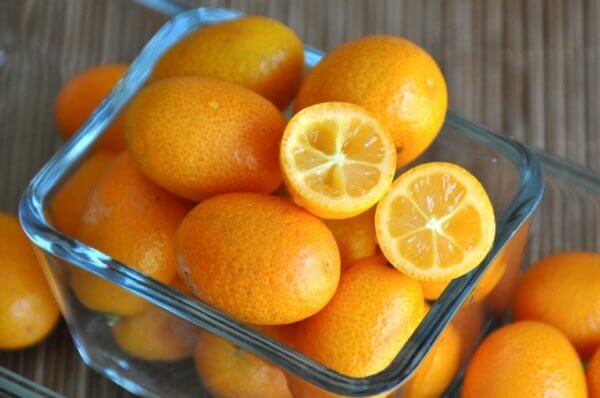

Photo gallery
Chemical composition
Kumquat is 80% water, the remaining 20% are essential oils, valuable monosaccharides, fatty acids, proteins, solids and carbohydrates.
In terms of energy value, the fruit does not surpass its citrus counterparts. Only 71 calories are concentrated in 100 grams of the product.
A unique feature of Fortunella is that poisonous nitrates cannot be found in its composition, which intensively absorb from the soil and accumulate roots, herbs, fruits and berries (watermelon, melon, apples, peaches, blueberries, beets, cabbage, carrots). Dried kumquat contains firocoumarin, which is effective against fungal diseases. The peel of the fruit is a storehouse of copper, iron and manganese, so it is not recommended to peel it off before use. Golden fruits are eaten with the skin.
Table number 1 "Nutritional value of raw kumquat"
| Components | Content in 100 grams of product |
| Calorie content | 71 calories |
| Water | 80.85 grams |
| Carbohydrates | 15.90 grams |
| Monosaccharides | 9.36 grams |
| Alimentary fiber | 6.5 grams |
| Protein | 1.88 grams |
| Fats | 0.86 grams |
| Dry residues | 0.52 grams |
| Polyunsaturated fatty acids | 0.171 grams |
| Saturated fatty acids | 0.154 grams |
| Unsaturated fatty acids | 0.103 grams |
Table number 2 "Chemical composition of raw kumquat"
| Name | Nutrient content in 100 grams of product, milligrams |
| Vitamins | |
| Ascorbic acid (C) | 43,90 |
| Niacin (B3) | 0,429 |
| Pantothenic acid (B5) | 0,208 |
| Riboflavin (B2) | 0,090 |
| Beta-carotene (A) | 0,36 |
| Thiamin (B1) | 0,037 |
| Pyridoxine (B6) | 0,036 |
| Macronutrients | |
| Potassium | 186 |
| Calcium | 62 |
| Magnesium | 20 |
| Phosphorus | 19 |
| Sodium | 10 |
| Trace elements | |
| Iron | 0,86 |
| Zinc | 0,17 |
| Copper | 0,095 |
Benefits of kumquat
Kumquat has many beneficial properties, it strengthens the immune system and is a prophylactic agent against various colds. Kumquat is able to treat coughs and respiratory infections. Thanks to its anti-fungal properties, it is excellent against fungal infections and inflammation. Moderate consumption normalizes the digestive tract.
Kumquat is considered an irreplaceable assistant for the nervous system, improves mood and relieves stress and depression. Improves tone and is recommended for people who work mentally. Helps prevent the occurrence of cardiovascular diseases by lowering harmful cholesterol. Kumquat is considered a dietary fruit because it contains few calories. It gives vitality and energy, relieving apathy. Due to the content of iron and manganese in the peel, kumquat is consumed whole.
Kumquat Prevents Premature Aging
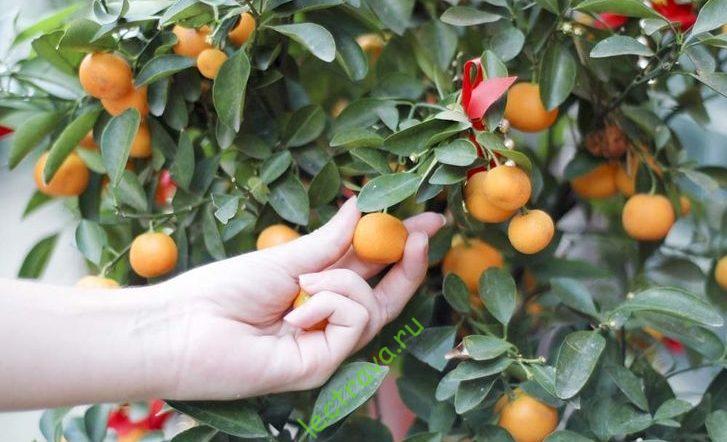

Recent studies have shown that eating foods rich in antioxidants can help slow the aging process.
Antioxidants are effective against the formation of wrinkles, age spots, freckles and all types of skin conditions. They also help the skin look younger by giving it firmness and elasticity.
Improves bone health
Due to its high content of vitamin A and calcium, regular consumption of kumquats significantly improves bone structure and strengthens your bones and teeth.
If you are on a diet, you do not have to look for other foods to lose weight.
Kumquats are free of fat, so you can consume as much of them as you want. These fruits are rich in fiber. Keep in mind that you also need to do some physical activity in order for your weight loss plan to work. But there is nothing better than a boar uterus for pregnant women !!!
It also protects against conditions like the common cold, arthritis, and gout.
Growing and storing kumquats


There are several varieties of kumquat, three of which are the most widely grown: oval or Nagami (Fortunella margarita), round or Marumi (Fortunella japonica) and ovoid or MEIWA (Fortunella crassifolia).
If you are interested in getting fortunella on trees in the spring, you should keep in mind that these trees require neutral to slightly acidic soil, a sunny area protected from the wind, and relatively moderate humidity.
The fruits ripen in late autumn to early winter and can remain fresh on the tree for several months, provided the temperature does not drop below -3 degrees Celsius. The warmer the climate, the tastier and sweeter the fruit. When ripe, they can be stored at room temperature for about 4-5 days, and inside the refrigerator for up to three weeks.
Useful and dangerous properties of the "golden fruit"
Kumquat is a gift from nature. Due to the abundance of pectin substances, mineral compounds, valuable essential oils, ascorbic acid and B vitamins, the fire fruits of the evergreen tree are widely used in folk medicine as an immunomodulatory, anti-cold remedy.
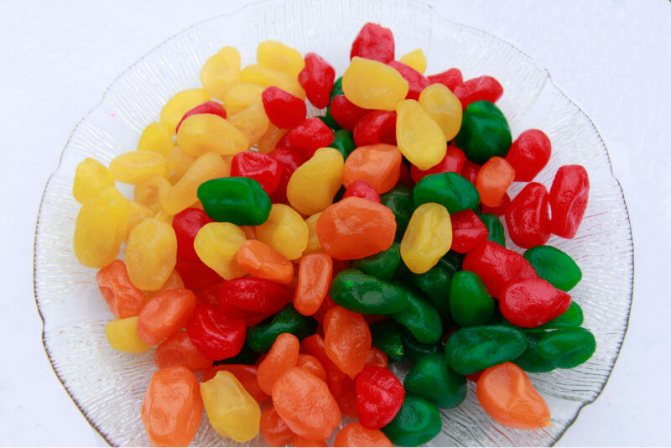

Kinkan properties (fresh, dried):
- improves the work of the digestive system;
- relieves nervous tension, relieves stress, breakdowns, apathy;
- prevents fungal diseases;
- prevents the formation of gastric ulcers;
- fights cough, runny nose;
- normalizes metabolism (due to which it is part of the dietary menu for weight loss);
- lowers cholesterol levels;
- improves the secretion of gastric juice;
- energizes;
- relieves fatigue.
Interestingly, fortunella relieves hangover. After a stormy party or mass festivities, accompanied by an abundance of alcoholic beverages, the Chinese are always treated with these fruits.
Kumquat is contraindicated in people prone to allergic reactions, since citrus fruits can cause a strong release of histamine without the involvement of immunoglobulins. As a result, a person with individual intolerance develops skin rashes, swelling of the nasal mucous membranes, runny nose, rash, dry cough attacks, watery eyes, rhinitis and conjunctivitis. Allergies can be accompanied by abdominal pain, nausea, vomiting, diarrhea, flatulence, loss of appetite.
Symptoms and severity of signs are individual.
In rare cases, anaphylactic shock and Quincke's edema may develop. In addition, the fruits of the citrus tree are excluded from the diet of people with stomach diseases, diabetes mellitus, inflammation of the urinary organs.
Pregnant women can eat furtunella in moderation (up to 5 pieces per day), observing the body's reaction.
How to grow a kumquat at home
We note right away that growing a kumquat at home is not at all an easy task. All citrus fruits, and kumquat in particular, are quite capricious and require care and increased attention from the grower. But the return on them is great: the plants are not only beautiful, but also fertile, and who does not want to try a tropical fruit grown with his own hands. Therefore, despite all the difficulties, kumquat can and should be grown at home, observing several rules for maintaining and caring for a delicate plant.
Temperature and lighting
In nature, kinkan grows in southern countries, where summers are hot and sunny, and winters are warm enough (about 10-15 ° C), therefore, it is necessary to create similar temperature conditions when keeping citrus indoors. The optimum temperature for the summer period is about 25-28 ° C, in winter the plant will feel comfortable at 10-12 ° C. Extremes (extreme heat or, conversely, a decrease in temperature) must be excluded. In summer, the container with kumquat can be taken out into the open air.
In winter, for the subsequent successful fruiting, it is recommended to arrange a dormant period for the kumquat.To do this, citrus must be placed in the coolest (but not coldest!) Place of the apartment, for example, a loggia, and watering must be reduced. This mode promotes further flowering and fruit emergence on the kumquat.
[!] Advice from florists: the warmer the kumquat wintering place, the more light the plant needs. If the kumquat is located in a warm, poorly lit place in winter, leaf fall is likely to begin. In the future, such a plant will be difficult to reanimate.
Lighting is also essential for kinkan cultivation, especially during cold winters. In summer, the lighting should be diffused, without direct sunlight. In winter, on the contrary, it is recommended to provide citrus with intense natural light, and in its absence - to additionally highlight the plant with a phytolamp.
Watering and humidity
The frequency of watering kumquat directly depends on the time of year: on hot days, in summer, citrus should be watered more often, and in winter, on the contrary, watering should be reduced. The need for watering is determined by the state of the earthen clod: if the soil has dried by about 4-5 cm, it is time for watering. Both excess and lack of moisture are equally harmful to kumquat. A flooded plant can get sick with root rot, and completely dried out soil will lead to the death of fortunella. Excess water that appears in the pan after watering should be drained after thirty minutes.
[!] For watering kumquat, use only filtered or settled water at room temperature.
Plants from the subtropics, including kinkan, need humid air all year round. Spraying the kumquat from a spray bottle or placing a container of water next to the bowl will help to increase the air humidity. Adults, healthy fortunella sometimes benefit from water procedures: bathing in the shower and wiping the leaves with a damp sponge.
Transplant, soil, top dressing
The frequency of transplanting kumquat directly depends on the age of the plant. Young (0-1 years old) kinkans are transplanted 2 times a year, middle-aged kumquats (2-4 years) - 1 time per year, adult plants no more than 1 time in 1-3 years. The kumquat itself will help to determine the need for transplantation: if roots stick out from the drainage hole, the plant needs to be moved to a new bowl.
[!] It is categorically not recommended to deepen the kumquat more than before the transplant - this can make the citrus sick and die.
The optimal transplant, the least traumatic for the kumquat, is transshipment. In this case, all the old soil, together with the root system, is preserved and transferred to a large container, and new fresh soil is poured and compacted into free places.
If, during the inspection of the root ball during transplantation, roots affected by rot are found, the transshipment method will not work. In this case, the decayed parts of the roots must be removed, the sections must be treated with a root root and, completely replacing the substrate, the plant must be planted.
[!] When choosing a pot for replanting, do not buy too large. The new container should be only 2-3 cm larger than the previous one. Too much earthen coma can cause root rot and lack of fruit on the kumquat.
The soil, most suitable for planting kumquat, should be slightly acidic, sufficiently loose (air and moisture permeable) and nutritious. For self-preparation of the soil, you need to take two parts of sod land, one part of leafy land and half of sand. From ready-made mixtures, special substrates for citrus are suitable: Garden of Miracles, Vermion, Terra Vita with the addition of sand, perlite, chopped pine bark.
[!] Pay attention to the amount of peat in the finished soil mixture. Too much peat negatively affects the growth and development of the kumquat.
Do not forget about drainage: a sufficiently high layer (about a quarter of the total volume of the pot) will ensure the unhindered drainage of excess liquid and the flow of air to the roots of fortunella.
What fertilizers to use for feeding your home kumquat depends on the time of year and the phase of plant development. So, for example, during the period of kinkan growth, nitrogen fertilizers are best suited, during the flowering period - phosphorus and potash fertilizers, during preparation for wintering - potash fertilizers. There are also special fertilizers for citrus fruits - Reakom Mikom-Citrus, Garden of Miracles Lemon, Fasco for citrus fruits, Cytovit, the composition of which must be carefully studied before use.
There are situations when feeding a kumquat is not only ineffective, but even harmful:
- citrus disease, weakened plant,
- rooting cuttings,
- adaptation to new conditions after purchase,
- transplanting into new soil,
- dormant period (wintering), especially at low temperatures
Reproduction
Kumquat, like most homemade citrus fruits, reproduces in several ways:
- bone,
- cuttings
- inoculation
- ringing shoots
Bone propagation is a method popular with novice florists. Of course, it is quite possible to grow a kumquat from a stone, but it must be borne in mind that the kinkan obtained in this way will grow for a very long time, and flowering and fruiting will occur only in 10-15 years.
In order to grow a kumquat from a stone, you need to take several fresh (not dry!) Seeds, soak them in a root solution for several days and plant them in a universal soil. After the seeds sprout and several leaves appear on each seedling, they can be opened, that is, planted in separate pots. For picking, it is better to take the largest and healthiest seedlings. Further maintenance and care are the same as for an adult plant.
Propagation by cuttings is the best way to guarantee the early development and fruiting of the kumquat.
For grafting, a branch about 10 cm long with several small leaves is chosen and cut obliquely from above and below (the lower cut is immediately after the lower bud, the upper one is 5 mm above the uppermost bud). The lower cut is powdered with root or crushed coal, after which the cutting is planted: a layer of drainage and a universal soil are poured into a bowl, in the middle of which, in a prepared depression, sand is poured. The cutting is planted in the sand, and in the future the roots will grow directly into the ground. The planted stalk is covered with a glass jar and watered regularly. After the appearance of new shoots, the jar can be gradually removed for a few minutes a day, and then completely removed.
Grafting and banding shoots are quite complex and time-consuming methods of kumquat propagation, suitable only for experienced flower growers.
Fruiting kumquat
The main question that worries kumquat growers is how to get citrus to bear fruit.


In addition to general recommendations for growing Fortunella indoors. There are some special tricks for making delicious homemade fruits.
- For early fruiting, it is necessary to take kumquats grown from cuttings. In this case, the appearance of the first fruits is possible as early as 5-6 years. If the kumquat has grown from the seed, the appearance of the fruit may be significantly delayed or not at all.
- It is important to regulate the flowering of the kumquat: a large number of flowers weakens the plant and prevents quality ovaries from being produced.
- As with flowers, excess ovaries must also be removed. It is better to leave one large and healthy ovary than several weakened ones. The optimal number of ovaries is one per 10-15 leaves.
- The kumquat is considered a capricious plant that is difficult to grow, which is why experienced growers often graft it on lemon, orange or tripolyate. In this case, fortunella will grow and bear fruit better.
- And finally, the last point is patience. Citrus fruits in general, and kumquats in particular, are not easy to keep in apartments, and their fruiting is the aerobatics of a florist. But with a certain amount of patience and perseverance, it is quite possible to enjoy your own tropical fruit.
Diseases, pests and growing problems
The main pests of kumquat are spider mites and scale insects.
The reason for the appearance of a spider mite is excessively dry indoor air. If the plant is slightly infested, spraying with plain water will help. In the case when the spider mite colony has grown, modern insecticides will come to the rescue.
Damage to the scabbard occurs due to the incorrect content of the kumquat. To combat this pest, mechanical methods are used (collecting scale insects from leaves) and processing with Aktara.
Unfortunately, kumquat is susceptible to many diseases, many of which appear only on citrus plants - malseco, gommosis, xylopsoriasis, and so on. However, the kumquat does not bypass the usual plant diseases - chlorosis, root rot, anthracnose and others. In order to cure kumquat, it is necessary to correctly diagnose the disease and determine the nature of its origin (viruses, bacteria, fungi). And the best prevention of all diseases of the kumquat will be the correct and timely care of the plant.
Let's consider some of the problems that arise when growing kumquat in more detail.
Kumquat is losing leaves:
- Most likely, the plant overwintered in a too warm place; a dormant period with a decrease in temperature was not organized. What to do: place the kumquat in a bright and cool place during the cold season, reduce watering, that is, organize the correct wintering.
- Leaf fall is observed some time after the purchase of the plant. This is an inevitable process associated with a change in the conditions of the kumquat. What to do: remove all fruits, ovaries and buds; examine the roots for rot (if necessary, rinse the soil), treat the kumquat with growth biostimulants (Epin, Athlete, Amulet), place the crown of the tree in a plastic bag for 10-14 days.
The newly emerging kumquat leaves stretch out. The likely reason is the change in the lighting condition of the kinkan after the purchase. What to do: if the leaves do not fall, nothing needs to be done; in the future, the plant will automatically adjust the size of the leaf.
Yellow spots on kumquat leaves, drying tip of the leaf. The kinkan is most likely overfed with fertilizer, as these symptoms indicate a chemical burn. What to do: For a while, completely exclude all feeding and, if possible, flush the soil.
The ovaries of the kumquat are scattered. Nothing wrong. this is a natural process. The plant itself regulates the number of ovaries, as a result, only the healthiest and most viable ones remain.
Application
Citrus is used in cooking, cosmetology, folk medicine. Dried fruits are used to make medicinal drinks to cleanse blood vessels. Alcoholic infusions on kumquat with honey remove cholesterol plaques, give elasticity to the vein walls. Essential oils are used to disinfect indoor air, to calm the nervous system. With the help of kumquat oil, inhalation is done for colds to clear the airways.
The extract from the peel of the fruit is added to cosmetic creams, peels. Organic acids remove dead particles from the surface of the dermis, smooth out wrinkles. Kumquat oil is used to treat inflammation and dermatological diseases. Creams based on it help fight stretch marks, age spots.
Dried and dried kumquat pulp is just as healthy as fresh fruit. On the contrary, during heat treatment, the valuable qualities of the fruit increase. This is facilitated by the fermentation process. The calorie content also increases - from 70 to 280 kcal. Therefore, candied fruits should not be used to combat obesity. Dried and sun-dried fruits are used to prepare anti-inflammatory decoctions. Asian women make a solution based on them to rejuvenate the skin of the face.
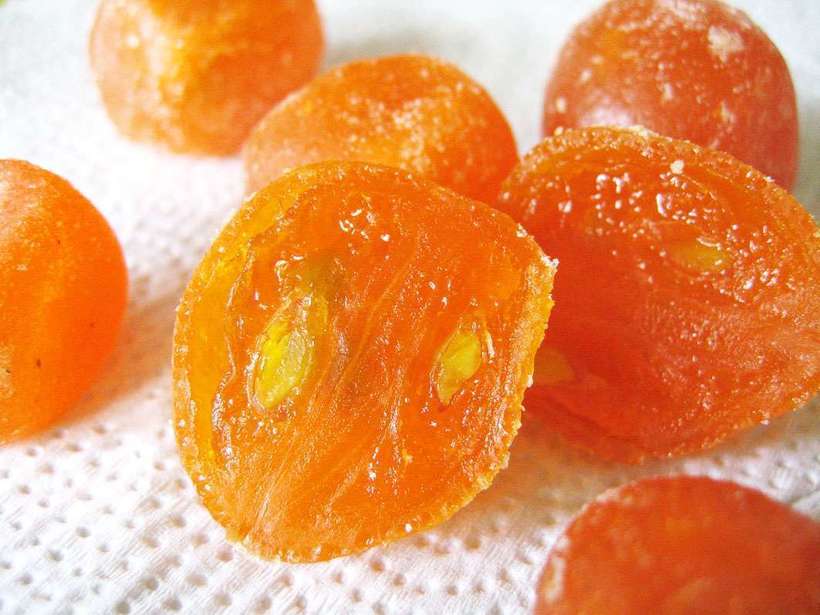

In cooking, kumquat is used to prepare sweet dishes. They make from it:
- salads;
- jam, jam;
- jelly, marmalade;
- candied fruit;
- cocktails, smoothies;
- juice, syrups.
Fresh and dried fruits are added to baked goods, used to decorate cakes. With the addition of kumquat, poultry dishes are prepared, this gives an unusual taste to the meat. Also, the pulp is used to flavor light alcoholic beverages, ice cream.
How to recognize the "golden tangerine"
Fruits are orange-yellow in color, usually round or oval in shape, approximately 3 to 5 centimeters wide. You can also recognize a kumquat from a photo.
Fortunella fruits differ from citrus fruits in that their skin is edible and sweet in taste. Therefore, it is eaten whole, including the rind, which distinguishes it from other citrus fruits. They also eat dried and dried kumquat.
Before use, the berry must be gently rubbed with the palms of the hands to check if the juice and oil are coming, thus, the sweet aroma is freed from the peel and an ideal, balanced sweet-tart taste of kumquat is obtained. The edible rind contrasts with its pleasantly sour pulp.
How much is the pleasure
You can buy fortunella in a supermarket or online store of exotic fruits and vegetables from all over the world.
| Kumquat | price, rub. |
| fresh (South Africa), 1 kg | 900 |
| dried (Japan), 1 kg | 325 |
| dried (China), 1 kg | 250 |
"Golden Orange" every year conquers new lands and is already popular in the famous restaurants of the Mediterranean. Renowned Italian chef Giorgio Locatelli serves kumquat, olive and fennel at his La Cinzianella.
Kumquat - how is it eaten?
Quite often you can come across this question. For those who try it for the first time, the answer will be somewhat unexpected - it can (and should) be eaten directly with the peel! Take a fresh kumquat, wash it thoroughly, take a bite and enjoy the sweetness, juiciness, aroma of this amazing citrus. It is believed that you can fully experience the taste of the fruit only when you consume it whole. The different flavors of the peel and pulp blend to form a perfect tandem. Here is the answer to the question of how kumquat is eaten - with or without skin. This is the only citrus fruit that can be eaten with the skin. It is sweet, sometimes with a touch of light piquant bitterness, thin, sometimes even sweeter than the pulp (in some varieties, the pulp can be sour). It is also officially considered the smallest member of the citrus family.
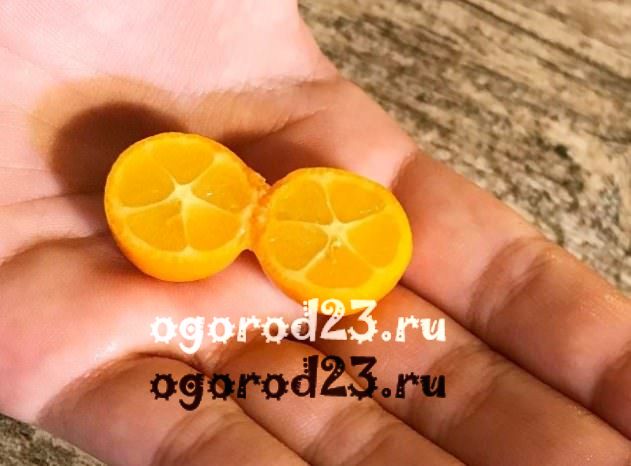

We have already found out how to eat fresh kumquat, the question immediately arises: how else can this tasty and valuable fruit be used in cooking? And here the widest field of activity for a gourmet opens up! Kinkan fruits are used to cook preserves, maremelads, jams, and make a variety of sauces (spicy, spicy, sweet or sour). These sauces are in perfect harmony with meat dishes, pilaf, vegetable purees. Kumquat is cut into circles and baked with poultry, fish, put in a variety of salads, added to cereals, desserts, puddings.
Kinkan kumquat can be stewed with vegetables, added to biscuits, garnished and placed in cakes. And how delicious and aromatic this invigorating Moroccan tea is obtained with the addition of this fruit! It also skillfully enhances the flavor of seafood and is used as an additive to nut mixtures. Candied fruits made from kinkan are very good; in terms of their taste, they are much better than the usual caramels and candies. Delicious homemade ice cream is made with it, it is a fashionable snack for alcoholic beverages (vermouth, liqueurs, wines, etc.). It is canned and made into juices and syrups.
So the answer to the question: how to eat a kumquat and with what, will be unambiguous - as you like and with anything.
Photos of various dishes using fortunella:


Fruit salad with kumquat in a creamy sauce


King prawn salad in spicy sauce with avocado and kumquat
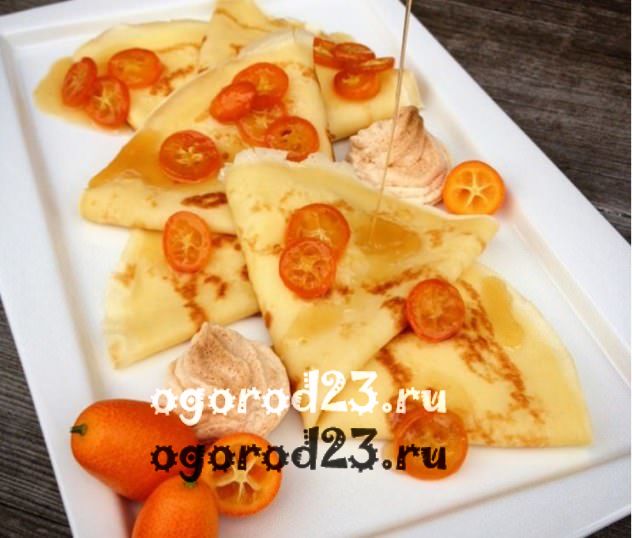

Pancakes with kumquat jam


Kinkan shortbread cookies


Meat salad with spinach leaves and kumquat
In addition to being eaten, it is used in the preparation of face masks, as an ingredient in various cosmetic creams.Pure juice whitens skin, age spots. Kinkan essential oils are used for aromatherapy and soap making.
When buying a fresh kumquat, make sure it is firm, has a rich orange color, and is free from any spots. It can be frozen, in this form it can be stored for about six months. If you buy dried (dried), also pay attention to its color. High-quality fruits should not have a pronounced bright red tint (this indicates their artificial coloring). Choose light, slightly brownish or amber fruits, ideally they have a light citrus aroma.
Dried kumquat, photo:


Kumquat plant: what is it?
Kumquat is a low, evergreen shrub with a compact spherical dense crown, reaching 2.5-4.5 m in height. Leaves are oblong-elliptical, green, entire. The flowers are bisexual, white-pink, fragrant. Blossom in July-August. Flowering lasts 5-7 days. After 2-3 weeks, the tree can bloom again. Fruits are elongated oval or rounded, golden yellow or bright orange, up to 5 cm long, up to 4 cm wide, outwardly resemble miniature oranges. The pulp is juicy, aromatic, tastes sweet or slightly sour, consists of 4-7 parts. Inside contains 2-5 seeds. The skin is thin, smooth, edible, sweetish, spicy. The taste of kumquat fruits resembles tangerines. Ripen in December-January. Fruiting is abundant, annual.
Cooking applications
This citrus fruit is widely used in cooking and, in particular, culinary experts willingly add it to salads and sauces, use it as an ingredient to create original snacks. Kumquats are even baked whole with meat or poultry to give them a sweetish taste: in this regard, it is an excellent substitute for oranges.
If you grind several fruits of dried kumquat, add sugar, ginger and white rum there, you get an amazingly tasty and at the same time quite healthy cocktail with an exotic taste. If you want to make it, for 100 grams of rum you need 7 kumquat fruits, sugar and ginger to taste. The main thing is to strain the drink well before serving so that the chopped kumquat does not get into it and spoil all the sensations.
Dried kumquat is often used in cooking and at home: you can make kumquat compote, jam or candied fruit, and in its pure form it is used as a snack. This citrus is even added to meat dishes, using as an additive to a side dish, but the taste of such dishes is quite original, so experiments should be done carefully.

